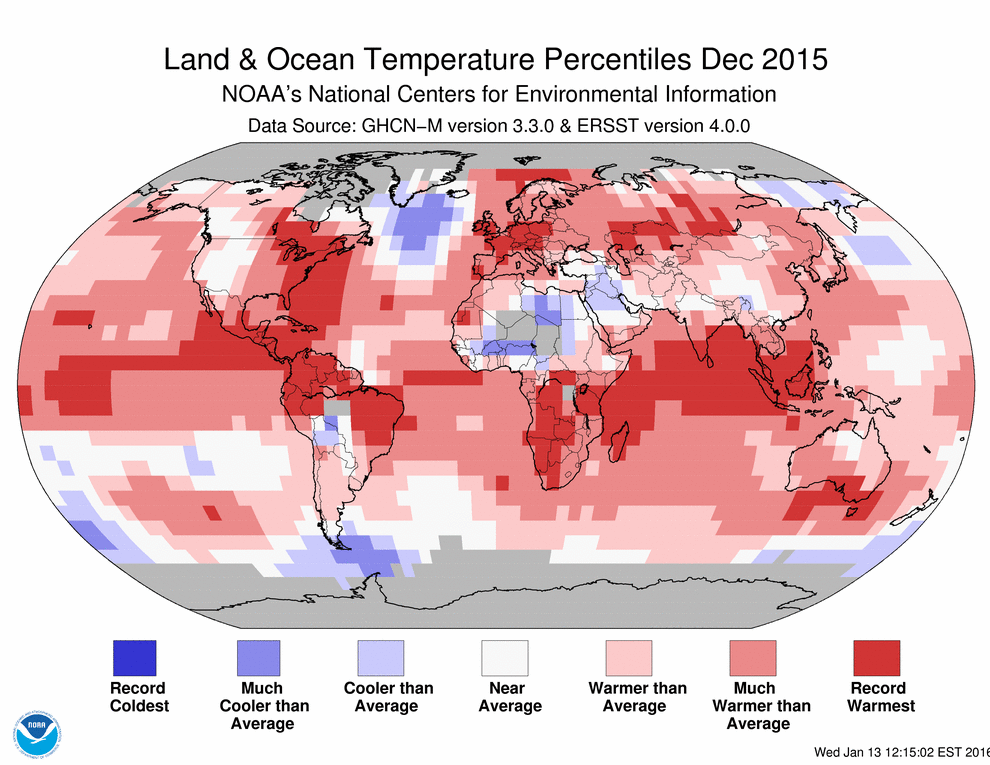
Residents carry packs of water during a heat wave that led to record electricity consumption in Buenos Aires December 30, 2013. With temperatures reaching 100 degrees, water and power outages blanket large swaths of Argentina's capital city, sparking protests and placing residents, particularly those in high-rise buildings, at risk. (REUTERS/Enrique Marcarian)
For the second year running, temperatures across the globe were the warmest since records were first kept in 1880.
The United States, despite record temperatures in December, fell just short of a record in 2015. But in separate analysis from the National Oceanic and Atmospheric Administration and NASA, the rest of the world led by parts of South America, Europe and Africa made up for that, ensuring 2015 broke the record by a widest margin ever.
Related: Thanks to December, 2015 was second warmest year on record
The 11 warmest years, with the exception of 1998, have occurred since 2000. Since 1880, Earth's average surface temperature has warmed by about 1.5 degrees.

“2015 was remarkable even in the context of the ongoing El Niño,” Gavin Schmidt, director of NASA's Goddard Institute for Space Studies, said in a statement. “Last year’s temperatures had an assist from El Niño, but it is the cumulative effect of the long-term trend that has resulted in the record warming that we are seeing.”
"By and far, the big story here was record warmth that was spread throughout the world," Thomas R. Karl, the director of NOAA's National Centers for Environmental Information, told reporters.
"For our land temperatures, they broke the all time warmest temperatures by a larger degree than any other record that we have had in the past," he said of the findings, which he called virtually certain. "The 2015 data continues a pattern we have seen over the last four to five decades."
During 2015, the average temperature across global land and ocean surfaces was 1.62 degrees (0.90 degrees Celsius) above the 20th century average, according to NOAA. This was the highest among all 136 years in the 1880–2015 record, surpassing the previous record set last year by 0.29 degrees and marking the fourth time a global temperature record has been set this century.
Related: California's drought is proving deadly to the state's trees
Ten months had record high temperatures for their respective months during the year. The five highest monthly departures from average for any month on record all occurred during 2015.
The globally-averaged land surface temperature was 2.39°F above the 20th century average. This was the highest among all years in the 1880–2015 record, surpassing the previous record of 2007 by 0.45 degrees. The globally-averaged sea surface temperature was 1.33 degrees above the 20th century average.
The higher temperatures also took a toll on the world’s snow cover.
According to data from NOAA analyzed by the Rutgers Global Snow Lab, the average annual Northern Hemisphere snow cover extent during 2015 was 9.5 million square miles. This was the 11th smallest annual snow cover extent since records began in 1968 and smallest since 2008.
Related: UN climate chief: Deal to reduce emissions within reach
It was a more mixed picture with ice sheets.
Recent polar sea ice extent trends continued in 2015. The average annual sea ice extent in the Arctic was 4.25 million square miles, the sixth smallest annual value of the 37-year period of record. The annual Antarctic sea ice extent, in contrast, was the third largest on record, at 4.92 million square miles – continuing a trend that goes back several years.
The announcement comes just over a month after world leaders in Paris agreed to the first-ever climate change agreement. Among the measures was a commitment to keep the rise in temperatures below 2 degrees C by 2100 from pre-industrial levels, meaning the world is already almost halfway to that point.
Schmidt and Karl told reporters that the odds favored another record in 2016, noting that meeting the obligations under the Paris deal will be increasingly difficult unless tough measures are taken to reign in carbon emissions in the coming decades.
